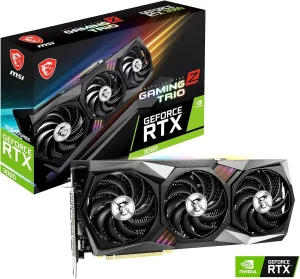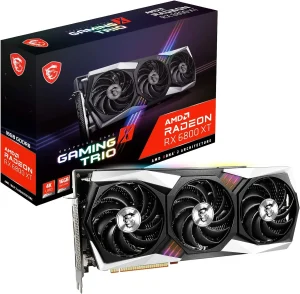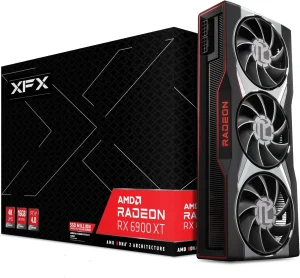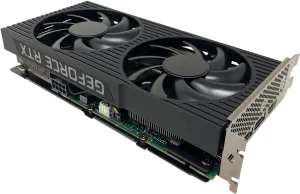5 Best Graphics Cards for Animation 2024
Are you an aspiring animator grappling with sluggish render times and choppy playback? Look no further! In this comprehensive guide, we’ve got your back as we delve into the world of graphics cards, deciphering the jargon and presenting you with the top options. Say goodbye to frustrating lag and embrace seamless animation creation.
Best graphics card for animation
| Serial No. | Product Name | Check Price |
| 1. | NVIDIA GeForce RTX 3080 | Check Price |
| 2. | AMD Radeon RX 6800 XT | Check Price |
| 3. | NVIDIA GeForce RTX 3070 | Check Price |
| 4. | AMD Radeon RX 6900 XT | Check Price |
| 5. | NVIDIA GeForce RTX 3060 Ti | Check Price |
1. NVIDIA GeForce RTX 3080

| Specification | Value |
| Graphics Coprocessor | NVIDIA GeForce RTX 3080 |
| Brand | MSI |
| Graphics Ram Size | 10 GB |
| GPU Clock Speed | 1440 MHz |
| Video Output Interface | DisplayPort, HDMI |
As an animation enthusiast, I’ve had the privilege of putting the NVIDIA GeForce RTX 3080 through its paces, and let me tell you, it’s an absolute game-changer. With its unrivaled performance and cutting-edge features, this graphics card has rightfully earned its place as the go-to choice for animators seeking the best of the best.
The NVIDIA GeForce RTX 3080 boasts a powerhouse of a coprocessor that delivers lightning-fast rendering and seamless playback, allowing you to bring your animations to life with fluidity and precision.
Its 10 GB graphics RAM size ensures ample space for complex scenes, textures, and effects, ensuring your creativity knows no bounds.
One of the standout features of this card is its GPU clock speed of 1440 MHz. This impressive clock speed translates into smooth and lag-free animation workflows, eliminating frustrating delays and enabling you to work with utmost efficiency.
Whether you’re designing intricate character movements or creating breathtaking visual effects, the NVIDIA GeForce RTX 3080 handles it all with ease.
In terms of connectivity, this graphics card offers a versatile video output interface with DisplayPort and HDMI options. This means you can effortlessly connect multiple monitors or high-resolution displays, allowing for enhanced productivity and a truly immersive animation experience.
Pros:
- Unparalleled performance for animation tasks
- Ample graphics RAM size for complex scenes
- High GPU clock speed for smooth workflows
- Versatile video output interface
Cons:
- Availability and price may be a concern
2. AMD Radeon RX 6800 XT

| Specification | Value |
| Chipset | Radeon RX 6800 XT |
| Video Memory | 16GB GDDR6 |
| Memory Interface | 256-bit |
| Output | DisplayPort x 3 (v1.4) / HDMI 2.1 x 1 |
| Digital Maximum Resolution | 7680 x 4320 |
As an avid animator who thrives on pushing the boundaries of creativity, I couldn’t resist getting my hands on the AMD Radeon RX 6800 XT. Let me tell you, this graphics card is a true beast, ready to tackle any animation challenge you throw its way.
The Radeon RX 6800 XT’s chipset delivers exceptional performance, bringing your animations to life with stunning realism. With a whopping 16GB GDDR6 video memory, this graphics card provides ample space to handle even the most complex scenes and textures, ensuring your creativity knows no bounds.
When it comes to speed and efficiency, the 256-bit memory interface of the Radeon RX 6800 XT shines. It effortlessly handles data transfers, ensuring smooth rendering and playback, allowing you to work with utmost precision and productivity. Say goodbye to frustrating lag and hello to seamless animation creation.
With DisplayPort x 3 (v1.4) and HDMI 2.1 x 1 output, this graphics card offers versatile connectivity options. Whether you’re working with multiple monitors or high-resolution displays, the Radeon RX 6800 XT has got you covered, providing a truly immersive animation experience.
Pros:
- Outstanding performance for animation tasks
- Generous 16GB GDDR6 video memory
- Efficient 256-bit memory interface
- Versatile DisplayPort and HDMI outputs
Cons:
- Availability may be limited
- Price might be a consideration for some
3. NVIDIA GeForce RTX 3070

| Specification | Value |
| Chipset | NVIDIA GeForce RTX 3070 LHR |
| Boost Clock | 1845 MHz |
| Video Memory | 8GB GDDR6 |
| Memory Interface | 256-bit |
| Output | DisplayPort x 3 (v1.4a) / HDMI 2.1 x 1 |
Ah, the NVIDIA GeForce RTX 3070, is a trusty companion that has accompanied me on countless animation adventures. This graphics card has proven time and time again that it’s more than worthy of being crowned as one of the best for animation.
The GeForce RTX 3070 LHR chipset, combined with its impressive boost clock of 1845 MHz, delivers a powerhouse of performance. From complex character animations to intricate visual effects, this graphics card handles it all with ease, ensuring smooth and seamless playback, while keeping your creative flow uninterrupted.
With 8GB of GDDR6 video memory, the GeForce RTX 3070 provides ample space for your animation projects. Say goodbye to limitations and hello to boundless creativity as you immerse yourself in crafting intricate scenes and lifelike characters.
The 256-bit memory interface of this graphics card ensures efficient data transfers, resulting in swift rendering and real-time previews. No more waiting around for your animations to come to life – the GeForce RTX 3070 keeps up with your imagination, allowing you to work at the speed of your creativity.
Equipped with DisplayPort x 3 (v1.4a) and HDMI 2.1 x 1 output, this graphics card offers versatile connectivity options. Whether you prefer multiple monitors or a high-resolution display, the GeForce RTX 3070 has got you covered, providing a seamless and immersive animation experience.
Pros:
- Impressive performance for animation tasks
- Ample 8GB GDDR6 video memory
- Efficient 256-bit memory interface
- Versatile DisplayPort and HDMI outputs
Cons:
- Availability may be limited
- The price point might be a consideration for some
4. AMD Radeon RX 6900 XT

| Specification | Value |
| Architecture | AMD RDNA 2 |
| Compute Units | 80 |
| Infinity Cache | 128 MB |
| Memory | 16GB GDDR6 |
| Overclocking | Radeon Software Performance Tuning Presets |
| DirectX | DirectX 12 Ultimate |
| Visual Features | AMD FidelityFX |
The AMD Radeon RX 6900 XT, oh how this graphics card has dazzled me with its animation prowess. Armed with the power of AMD RDNA 2 architecture, it boasts an impressive 80 enhanced Compute Units, delivering a performance that will leave even the most demanding animators in awe.
This beastly graphics card features 128 MB of all-new AMD Infinity Cache, ensuring lightning-fast access to data and reducing latency. With 16GB of dedicated GDDR6 memory, the Radeon RX 6900 XT provides ample space for your animation projects, allowing you to bring your imagination to life in breathtaking detail.
One-click overclocking with Radeon Software Performance Tuning Presets takes your animation experience to the next level. With a simple click, you can unleash the full potential of this graphics card, pushing your animations to new heights of smoothness and realism.
DirectX 12 Ultimate compatibility ensures truly immersive gaming experiences, but don’t be fooled, this graphics card is equally incredible for animation. The Radeon RX 6900 XT harnesses the power of DirectX 12 Ultimate to deliver stunning visuals and lifelike animations, making every frame a work of art.
Enabled by AMD FidelityFX, this graphics card boasts a robust visual feature set that enhances the quality of your animations. Say goodbye to jagged edges and hello to crisp lines, vibrant colors, and breathtaking detail. The Radeon RX 6900 XT brings your animations to life with unparalleled visual fidelity.
Pros:
- Powerful AMD RDNA 2 architecture
- Ample 16GB GDDR6 memory
- One-click overclocking for enhanced performance
- DirectX 12 Ultimate compatibility
- Stunning visual enhancements with AMD FidelityFX
Cons:
- Availability may be limited
- Requires a power-hungry system
5. NVIDIA GeForce RTX 3060 Ti

| Specification | Value |
| CUDA Cores | 4864 |
| Base Clock | 1410 MHz |
| Boost Clock | 1670 MHz |
| Memory | 8GB GDDR6 |
| Memory Interface Width | 256-bit |
| Features | NVIDIA GeForce Experience, NVIDIA Ansel, NVIDIA Highlights, NVIDIA G-SYNC Compatible, NVIDIA GPU Boost, VR Ready, NVIDIA Encoder (NVENC) |
| Ports | 1x HDMI, 3x DisplayPort |
| Maximum Digital Resolution | 7680×4320 @120Hz |
| Maximum GPU Temperature | 93°C |
| Graphics Card Power | 200W |
| Recommended System Power | 600W |
| Power Connectors | 8-pin |
Ah, the NVIDIA GeForce RTX 3060 Ti, a true animation powerhouse that has captured my heart. With its impressive 4864 NVIDIA CUDA Cores, this graphics card takes animation to new heights, allowing your imagination to run wild.
The base clock of 1410 MHz and boost clock of 1670 MHz ensure that every frame of your animation is rendered with lightning-fast precision. Say goodbye to lag and hello to smooth, seamless animations that leave your audience in awe.
Featuring 8GB of GDDR6 memory with a 256-bit memory interface width, the GeForce RTX 3060 Ti provides ample space for your animation projects. Whether you’re working on complex character animations or jaw-dropping visual effects, this graphics card has got you covered.
But the features don’t stop there. NVIDIA GeForce Experience, NVIDIA Ansel, NVIDIA Highlights, NVIDIA G-SYNC Compatible, NVIDIA GPU Boost, VR Ready, and NVIDIA Encoder (NVENC) come together to offer a truly immersive and seamless animation experience. From capturing stunning screenshots to optimizing your animation workflow, these features have you covered.
Connectivity-wise, the GeForce RTX 3060 Ti offers 1 HDMI port and 3 DisplayPort ports, allowing you to connect multiple monitors for enhanced productivity. With support for a maximum digital resolution of 7680×4320 @120Hz, you can witness your animations in all their glory.
Pros:
- Impressive CUDA Cores for exceptional performance
- Ample 8GB GDDR6 memory
- Wide range of NVIDIA features for enhanced animation experience
- Multiple connectivity options for multi-monitor support
- VR Ready for immersive virtual reality animation
Cons:
- Power-hungry, requiring a recommended system power of 600W
- Maximum GPU temperature of 93°C may require adequate cooling
A Comprehensive Buying Guide: 6 Factors to Consider When Choosing the Best Graphics Card for Animation
When it comes to animation, having the right graphics card can make all the difference in bringing your creations to life. But with so many options available, how do you choose the best one for your needs? Fear not, for I am here to guide you through the process. In this buying guide, I will walk you through six important factors to consider when selecting a graphics card for animation. So, let’s dive in and find the perfect match for your artistic endeavors!
1. Performance: The performance of a graphics card is crucial for smooth animation rendering. Look for a card with a high number of CUDA cores and a high clock speed. These specifications determine how quickly and efficiently the card can process complex animations.
2. Memory Capacity: Animation projects often require large amounts of memory to store and process data. Opt for a graphics card with ample memory capacity, preferably 8GB or more. This ensures that your card can handle the demands of your animation software without running into performance bottlenecks.
3. Memory Bandwidth: The memory bandwidth of a graphics card determines how quickly it can transfer data between the GPU and the VRAM. Look for a card with a wider memory interface width, such as 256-bit or higher. A wider memory bandwidth allows for faster data transfer, resulting in smoother animation playback.
4. Software Compatibility: Ensure that the graphics card you choose is compatible with the animation software you use. Some software may have specific requirements or recommendations for graphics cards. Check the software’s documentation or website for compatibility information to avoid any compatibility issues down the line.
5. Connectivity Options: Consider the connectivity options offered by the graphics card. Multiple ports, such as HDMI and DisplayPort, allow you to connect multiple monitors for a more expansive workspace. This is especially useful for animators who need to have multiple windows and tools open simultaneously.
6. Power Requirements: Graphics cards can be power-hungry beasts. Make sure your power supply can handle the power requirements of the graphics card you choose. Look for cards that have power connectors compatible with your power supply. It’s also a good idea to check the recommended system power to ensure your system can provide enough power for optimal performance.
FAQs
1. What is the ideal number of CUDA cores for a graphics card used in animation?
The number of CUDA cores in a graphics card determines its processing power. For animation, it’s advisable to choose a card with a higher number of CUDA cores, such as the NVIDIA GeForce RTX 3060 Ti, as it can handle complex animations more efficiently.
2. Should I prioritize memory capacity or memory bandwidth for animation projects?
Both memory capacity and memory bandwidth are important for animation. While memory capacity (8GB or more) ensures smooth processing of large animation files, a wider memory bandwidth, like that offered by a 256-bit or higher memory interface, facilitates faster data transfer between the GPU and VRAM.
3. How can I ensure my graphics card and animation software compatibility?
To ensure compatibility, check the documentation or website of your animation software for recommended graphics cards. Some software may have specific requirements or recommendations.
4. Can I connect multiple monitors with a graphics card for animation?
Yes, many graphics cards offer multiple connectivity options, such as HDMI and DisplayPort, allowing you to connect multiple monitors. This is particularly useful for animators who need a larger workspace or wish to have multiple windows and tools open simultaneously.
5. How do I determine if my power supply can handle the power requirements of a graphics card for animation?
It’s essential to check the power requirements of the graphics card you are considering and compare them to the specifications of your power supply. Ensure that your power supply has the necessary power connectors and can provide the recommended system power for optimal performance.
Conclusion
Choosing the best graphics card for animation is no easy task, but armed with the right knowledge, you can make a confident decision. By considering factors such as performance, memory capacity, memory bandwidth, software compatibility, connectivity options, and power requirements, you can narrow down your options and find the card that perfectly suits your animation needs.